The Accelerate Kootenays direct current fast charger (DCFC) network is filling in right now during the winter of 2017/2018. In December, Radium and Canal Flats came online, and in the last two weeks, Greenwood, Christina Lake, Castlegar, Salmo and Creston all came online as well (as I write this, Jaffray might be online now too!) That brings the total tally to 8 (or 9?) out of 13 installed so far. I recently had a trip in our 2014 Nissan Leaf (a short range electric vehicle, or EV) that I think will illustrate what the fledgling DCFC network will mean to those of us with (or contemplating buying) short-range EVs. If you want to skip the trip report itself, head right to the big heading of “Conclusions” near the bottom.
We had two big snowfalls overnight last week (Jan 23/24 and 24/25; 60cm total), which had me itching to go skiing. A friend invited me down to Rossland to ski Red Resort – typically I ski at Whitewater (since it is so close to Nelson, plus I like the vibe there), but I hadn’t skied Red in 3 years, so decided to make the trip. My plan was to drive to Rossland via Castlegar/Trail, and plug in at the only Level 2 charger in downtown and catch a ride with my friend up to the hill. After skiing, the car would be fully charged and I’d be ready to head straight to the Nelson Nordic Ski Club, where I help coach the Jack Rabbits program on Thursday nights and Sundays.
I felt I had left plenty of time to get there (1.5 hours, when in summer the trip is about 1 hour 10 minutes), but I should have known better after a big snowfall in the alpine that had freeze/thaw conditions in the valley that either road conditions or an accident would slow down traffic. Just as I was leaving the last of Castlegar behind, I could see towards the end of a straight stretch a very large line-up of cars. Having been stuck for a few hours in such a line-up recently in November (no side roads for a bypass), I made a quick decision to turn around and head back to Castlegar to use the newly opened fast charger and drive up and over the Strawberry Pass instead.
Back in Castlegar and sucking back the electrons, I did some quick math to figure out how full I needed the car to be… the car uses about 1.5 kWh per 300 m of climbing, and I needed to get up and over the Strawberry Pass at 1575 m, the Castlegar charger is at about 475 m, so that’s 1100 m / 300 m *1.5 kWh/300m = 5.5 kWh! You can see how going uphill really sucks back the juice! To be conservative, I then looked at the distance (Google Maps to the rescue) of 52 km and divided this by my worst winter energy efficiency of 5 km/kWh = 10.4 kWh. Hmm that’s a total of basically 16 kWh, which is most of what my car can store these days! (My 2014 Leaf started with 21.7 kWh usable, and I’m somewhere around 83% available of new, so ~ 18 kWh. Due to battery chemistry and cold, not quite all of that is available in winter either.)
So I charged right to 90% on the fast charger, which because of the cooler temperatures, and starting at about 50% already, took just under 30 minutes (fast chargers work quicker when your battery is at a low state of charge). I would have left sooner, but got deep into a conversation with the guy at the chamber of commerce on the coming rEVolution. After that I was off up the hill!
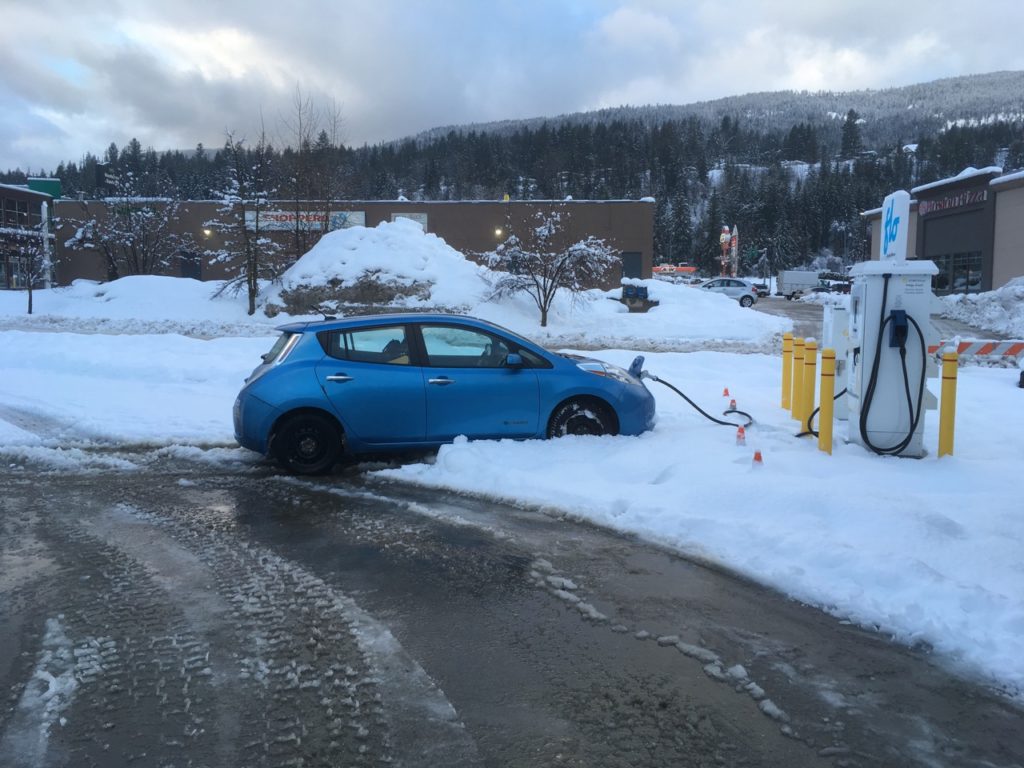
The plow didn’t quite do enough in the parking lot! The Leaf is a 2wd champ in snow though, so no problem.
The road was horrendous leaving Castlegar on the first climb – it must have been snowing and freezing so fast the highway maintenance crews couldn’t keep up. It was like driving on a pothole-filled gravel road that hasn’t seen a grader in months. Once up past the freezing line, the road became much nicer thankfully (at about 1,000 m elevation).
Nearing the Strawberry Pass, I was right on target for energy consumption. Easy sailing from here to Red Resort, and what a beautiful morning for a drive!
- Used 68% to climb 1,100 m over 36 km! 16 km left to go to Red, and another 4 km from there to Rossland… thankfully all slightly downhill (loss of 500 m), so I knew I’d make it. (In fact I arrived at 18%!)
- The view of the Rossland range
Instead of my entire day being wasted, the DCFC network enabled me to get to the ski hill just a 1/2hr after opening (about 45 min later than I planned, and that includes an extra 15 mins of driving by doubling back and taking the longer route).
- I crammed my car into a snowbank and saved myself a 5 minute walk haha!
- Sunshine and powder, yeah!
- Granite mountain was looking very good – I had an amazing day on the skis and was knackered by 1:30 pm.
Since I had parked at Red (I didn’t want to drive down to town, park at the Level 2 charger, then wait for the shuttle bus to take me back up and miss out on some powder!) I didn’t have enough juice to get all the way to the Salmo DCFC, so had to stop in Rossland for almost an hour. In the future we’ll have a DCFC in pretty much every town (similar to gas stations now), so 5 minutes would have been enough to get me there otherwise.
- Upon arrival in Rossland, evidently no one had used the charger in some time. I could just reach the unit without diving into the snowbank, but the cord was somewhat stuck and required some serious tugging to get it out.
- Rossland was preparing for the annual winter carnival (running for over 100 years straight!) – ice castle under preparation. I also stopped at our favourite chocolate maker (Mountain Nugget) and stocked up.
- They turn one of the city streets into a slopestyle course for a few days! Here they are preparing for rails to be installed.
After a quick 12 min stop at Salmo for a charge (and a stretch!) to cover the last 45 km back to Nelson, I was back on the road to the Nelson Nordic Centre to help coach Jack Rabbits. I had stayed for almost the full day at Red, so ended up being 45 min late for JR. If Rossland had a DCFC too as mentioned earlier (or Trail), I would have made it on time no problem.
- Just before I unplugged at 12 minutes
- The stop at Nelson Nordic for coaching – I missed the first 45 minutes, thankfully we tag-team coaching so I was covered.
Conclusions
Before the DCFC network, if I was in this situation, I would have been ‘stuck’ in Castlegar for 2 hours on a Level 2 charger and headed straight back home: day off wasted with no powder skied. Bummer. So, even if your regular trip plans don’t need to include a scheduled stop at a DCFC, some unforeseen event may very well make you very glad it is there as a backup for your regular trips!
Charging the top 30% of the battery is expensive! I spent almost 1/2 hour charging to 90%, which cost me $8.76 for 6.73 kWh (@ $9/0.5hr of charging), or $1.30/kWh! I won’t be doing that too often… but when you need a charge quickly, you pay for the convenience I guess. If I didn’t let myself get stuck in that conversation, my $/kWh would have been somewhere under $1/kWh, since the car really slows down a lot starting at about 80% (see my DCFC charging video). Still expensive.
Conversely, charging from the lower half was much better; at 13% I was getting ~40kW and slowed down to about 30kW by 52% in 12 minutes, which cost me $3.75 for 7.2 kWh, or $0.52/kWh. Still 5 times more then I pay at home, but that’s about the same spread to pay someone to make you food as to do it yourself, so I’m ok with that for the occasional use.
The Leaf at least doesn’t seem to be impacted by cool temperatures as much as other EVs (at least anecdotally). At a low SOC, I was getting about the same kW input to my car as I did in 2015 at the Penticton DCFC linked in that video above. Maybe this would be different at -15C. (Maybe I’ll still get a chance to test that out this winter!)
- Charging in Salmo, my battery had warmed up a bit from the downhill out of Rossland and the short highway drive, so I was getting almost full power.
- At over 50% SOC, I was still getting 30 kW – not bad for winter!
For short-range EVs, I think the network will enable the type of day-trips that are just a bit too far to cover on one charge, in which case paying about $5 for a top-up to get home, plus the $2 for the initial charge, for perhaps 180 km of driving will still make it cheaper to take the EV then any gas car. We have many many types of trips we would like to do that fit into this category, so I think we’ll be getting a fair amount of use out of the two closest chargers to us – Salmo and Castlegar. I expect the same will be true for other local Leaf owners.
I really wish there was one in Nelson too – some evenings I get home from work and want to head out right away to the nordic area (either to coach or just go for a ski), but I have to head home first for an hour to top up. A DCFC would mean a 5 minute stop would be sufficient.
I would not buy a short-range EV planning to use a DCFC on an every day commute. With only one unit in each town, you are gambling somewhat that the station will not break or be occupied, plus the cost savings will be much less if you can’t rely on home charging only.
Will I be taking inter-regional trips every other weekend with my short-range EV? Not likely: the cost will become prohibitive if you start driving distances of 300+ km. It’s a bit hard to calculate exactly, since the Fortis DCFC units are charging $ by time connected, and charging speed varies somewhat, but I estimate that at the current rate of $9/0.5hr (or $18/hr), I would spend about $2 (initial home charge) + $27 (1st to 3rd DCFC, 1/2hr each) or ~$30. That’s about the price of my gas car (a Forester), except the Leaf is smaller (which might make the difference depending on recreational activities planned) and the trip would take about 1 hr longer (we’d stop for 0.5hr over that distance anyways with our kids). We will likely do a trip like this once per year though – I just like driving electric cars that much better!
Stay tuned for another blog post on what the DCFC network means for the longer-range EVs!
- R1T Efficiency Tests: Bikes and Ski Boxes - March 30, 2024
- Adding Outdoor Accessories to my R1T - December 1, 2023
- Why an EV truck? Why the R1T? - October 8, 2023
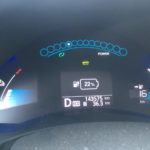

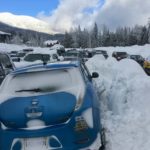

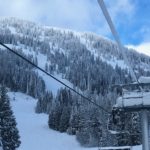
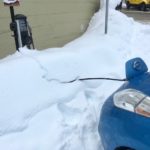


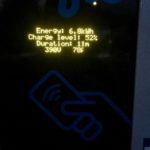
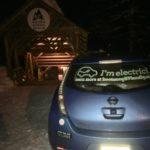
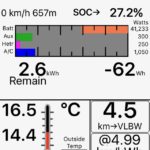
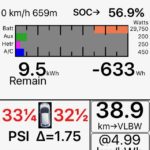
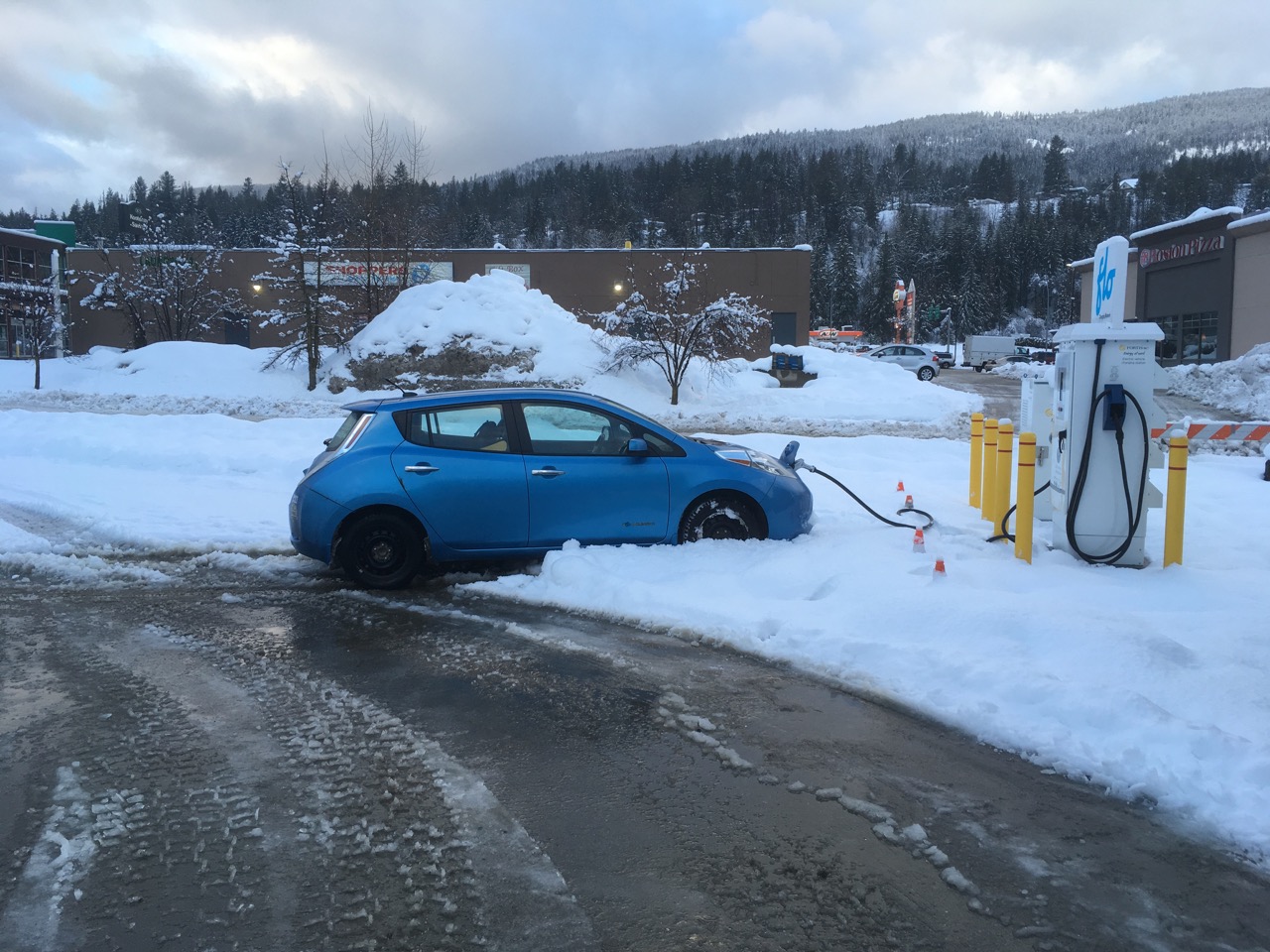
Great post – you’re blog entries are part of what’s going to get me out of my gas car, one day. Quick question: what would you reckon your costs were (roughly, of course) per kilometre for your travels in this post?
I covered 205 km at a cost of $12.50 DCFC + ~ $2 at home at the end of the day for $14.50, which yields $0.071/km. My gas car would have been 205 km * 9.5 L/100km *$1.24/L = $24.15, or $0.118/km. The spread is larger if you include maintenance, since the gas car has cost about 10x as much in maintenance costs for the same equivalent km’s. Cheers!
I’d also add that even for longer range EV, the presence of DFDC at closer intervals eases range anxiety. Usually on a trip to Calgary, we top up the gasser in Radium, due to it being easier there than Banff, Canmore, or further East. In similar fashion, grabbing a quick top up in Cranbrook, or Canal Flats before a final near-full charge for the journey to the DFDC wasteland that is Alberta.
Very good point too David. Regardless of your vehicle range, denser fast chargers will add convenience for us all 🙂
Interesting that Fortis has gone with a time-based cost system. I gather that they’ve brought FLO in to look after the system? From what I’ve seen of the DCFC system in the land of BC Hydro, the units are managed by Greenlots and the power is charged by the kWh (35 cents per kWh). I thought that was a little on the pricey side – the costs you’ve detailed are even higher! At some point, you would hope that the cost of the units themselves (hardware and management) would be spread across more drivers and the power costs would come down to a more reasonable level.
I note that Tesla drivers who don’t have bundled supercharging pay differently, depending on the local laws. In BC, the BCUC requires you to get an exemption if you aren’t a utility…if you want to ‘resell’ power at a per kWh rate. Perhaps Tesla will go that way in the future, but at the moment I understand that they charge by time, with two rates available. I forget where the cutoff is, but if you’re over, say, 50 kW of draw, you’ll pay a higher per minute rate than if you’re below. The idea is that you’ll average out to approximately the actual cost of the kWh consumed.
Judging by the photos, is it safe to assume that the units are all dual head – CHAdeMO and CCS?
All of the Accelerate Kootenays chargers (both Level 2 and DCFC) are Flo (AddEnergie) hardware and on the Flo network, regardless of who ended up being the owner. In the east Koots, BC Hydro owns the DCFCs, and in the west Koots, Fortis owns them. The units themselves do not have utility grade meters, so apparently under the Weights & Measures Act (federal), they shouldn’t (or can’t?) be used to track energy dispensed to a user. This is of course crazy, as the unit is more then accurate enough for the purposes of a consumer. I’m not sure how the other units in BC get around this.
I do think we’ll be in a state of flux for the next 5 – 10 years on the fast charger side as we lurch between too few chargers to more then needed (for EV density in a given area, or travelling through an area). It’ll take some time to sort it all out, but I think the consumer cost will end up being lower than what I paid on this trip in the long run. $0.35/kWh might not be enough to sustain the infrastructure though…
As a consumer, I like what Tesla has done for charger cost; however, I fail to see how they will break even on it. I think of it as a loss-leader for them to encourage people to buy a Tesla. And this would work with me too, except they seem to have a total aversion to buttons and simplicity lol.
All of the units being installed are dual standard 🙂
Fantastic cost breakdown, Andrew. I have been trying to answer a lot of these same math questions via (lurking) research on various BEV/PHEV forums.
The recent extended cold snap across N. America had a lot of EV owners facing a cold weather challenge they’d never considered. Some were doing good math, others were making WAG’s.
You were an early EV-influencer for me a few years ago (we were out on a MTB ride) but I wasn’t ready to go BEV at that time. I looked at PHEV but they didn’t seem ready for prime time either. I wanted more capability; better electron storage capacity to offset range anxiety and better charging uptake speed. It feels like I waited a long time but *maybe* the time is right now.
Two vehicles have caught my eye (and yours no doubt), the 2018 Leaf and the 2018 Outlander PHEV. I haven’t seen either yet, on paper the Outlander would make more sense living in Rossland due to its higher ground clearance vs. snowfall. My wife is concerned getting in and out of the Strawberry Pass or Biathlon parking lots (as an example) will be tough to impossible in a low ground clearance vehicle like the 2018 Leaf if they aren’t plowed.
I like the technology deployed in the Leaf as compared to the Outlander, but I like the lack of range anxiety with the PHEV. I’m carefully scouring the Web for reviews in both. Mixed opinions on the Outlander, and generally positive opinions on the Leaf (with the main complaint being no TMS). Either one would be a fine choice, but I’m always looking to the next 6mth horizon and seeing things like a 60KwH pack coming for the 2019 Leaf, or a just on the horizon AWD CUV/SUV with decent BEV range. It kinda feels like we are 1yr away from that ‘next level’ of range anxiety removal.
Of course I would love to be in any of the Tesla models, but they are out of my price range. Speaking of price, my goal is to use ScrapitBC to get rid of our 1999 Audi for the $6,000 credit, then it’s either $2,500 or $5,000 credit for the CEVforBC credit dependent on vehicle battery size. An $8500 or $11,000 credit is looking pretty tasty and I want to take advantage of it while it’s available.
I know the Leaf and Outlander are completely different load carrying vehicles. If we get the Leaf we can rely on our Honda Pilot for heavy lift and range, while identifying the Leaf as primary use. If we get the Outlander it will become primary driver as well as heavy lift and range, the Pilot will get relegated to drive only if the Outlander is already out on the road. Either way the Pilot (2004 with 280,000kms) is also getting close to end of lifecycle and will probably be replaced by BEV in a couple of years. If we buy the Leaf now the next purchase will be a CUV or SUV with beyond-the-Kootenays range, if we buy the Outlander now the next purchase will be a Leaf-like Kootenay commuter.
Lots for me to consider.
You have a better sense of things, what are your thoughts regarding available or very near-future BEV/PHEV vehicles for Kootenay family transportation? Given the choice, what are you thinking for next vehicle?
Phew, sorry for the wall of text. Hope it makes sense.
Shaun Taylor
Hey Shaun! I didn’t ride once in Rossland this past summer (2017), which is a real shame, as your trails are awesome. My wife and kids were lamenting that fact too. Now with the fast charger in Castlegar, should be even easier to make the trip over on a weekend.
On to your question(s) though… the lack of clarity on when/what BEVs are forthcoming is quite a conundrum! And it feels worse the closer you are to having to make a decision on a new car purchase. You might be surprised to find I am going through some similar thoughts as you right now, as I am starting to begrudge having to charge at either end of my commute and drive slowly on Thursdays to conserve enough range to get my boys from school, sneak in 45 minutes of charging, and eke my way up to Nelson Nordic and back. I’m actually doing another evaluation right now of whether to replace the Leaf (keeping the Forester), or replace the Forester: the former would mean more capital costs (and some nostalgia at the idea of keeping the car for my son to drive in 7 years), and the latter would mean a drop in utility, since there is no in-kind BEV replacement right now. But I digress – I only state this to note that everyone’s situation is so unique when it comes to evaluating what to do.
So, I will take a whack at your questions…
1) Concern with snowy parking lots/roads around Rossland area in a Leaf (or similar): definitely a valid concern, but really only a handful of days per year, at least in my experience in 4 winters thus far. I’ve only managed to get it stuck once, and that was unplowed heavy snow of about 20 cm. Other than that, with good winters, and some judicious use of throttle (not being afraid to turn off traction control and pin it when necessary), you’d be surprised at how capable these front wheel drive vehicles can be. BUT, they are definitely no Subaru or Mitsu AWD, that’s for sure!
2) Credits for buying EV/PHEV: I am unsure how long the Scrap It program will be around, but it does run out early in the year (ie before May/June) and no guarantee they will “refill” it the following year. The CEV for BC I suspect will stick around for at least as long as the NDP gov’t (which might not be saying much.) There is a rumour that the feds will bring out a program this year too. Hard to know whether to wait for the next budget cycle announcements or not… the provincial is at least only a few weeks away now, while the Feds should be early to mid March.
This article (https://electrek.co/2017/05/29/canada-electric-vehicles-strategy/) from last year had Garneau quoted as stating a more comprehensive EV program by end of 2018 (but I suspect any major funding announcements would come in budget update). The NRCan website http://www.nrcan.gc.ca/energy/efficiency/transportation/19198 shows how they so far have been focussing on charging infrastructure deployment (which is where a good portion of the funding for the Kootenay DCFC network came from).
3) The “1 year away” conundrum… this is a tough one! To be honest, I haven’t seen much promise for a proper SUV BEV vehicle coming anytime soon. The closest might be the Audi e-tron quattro, slated to release as a 2019 model late this year, but if it stays close to the style of the A4 allroad, it won’t have the clearance or approach/departure angles of a Subaru, nor the cargo room (stated already as 620L, vs my Forester with 850L). The Kia Niro (late 2018) is only slated for front wheel drive, and is in between the size of a CR-V and HR-V (ie smallish). Nissan might have a trick up their sleeve when they announce the 2019 Leaf in at Yokohama autoshow this fall by also announcing a CUV type vehicle… which may or may not be AWD. However I don’t think it would be the Rogue, they have hinted already at something the size of the Qashqai (or however you spell that!)
Then we have the bunch of cars supposedly coming by or just after 2020: Model Y (which if they stay with the UI of the Model 3 I’ll be passing on… having to use the touch screen to change wiper speed is just plain dumb and dangerous!), Ford & Chevy CUV/SUV, VW Crozz (CUV with AWD), and Subaru in 2021. Most have been hinting at vehicles on the smaller size though. No one seems willing to tackle a BEV that is about the size of a Forester or Outlander, aside from Tesla with the expensive Model X.
So for now, it looks like the Outlander is really the best compromise if you want to get some EV miles under your belt. I think it will also be a better vehicle offroad then their ICE vehicles or a Subaru, since it has a dedicated electric motor per axle (basically a full-time 4wd system, with none of the drawbacks), and it has some towing ability.
I’d look at it more closely myself, except it won’t really help me out, since I want an EV (or PHEV) that can do my commute round-trip more then I want an EV for the minimal amount of driving my wife does here from Nelson daily.
Then I’d replace the Pilot soon with a cheap used Leaf (I might have one for sale soon ;), which will serve as a good second car and would do just fine around here most of the year.
One thing you didn’t mention was whether both vehicles need to be capable of getting into/out of snowy parking lots or not, so my latter suggestion might not help you there. (Actually are you scrapping the Pilot? Or do you have two cars now and are scrapping something else?) We can chat in more detail if you’d like – just drop me a line at achewter @ gmail.com.
A really thoughtful and detailed reply Andrew, not surprising of course. I appreciate the details you put into your thoughts and considerations.
If you don’t mind, let’s keep our discussion public. That way more people can benefit from the topic at hand, as I feel more and more people are going to be facing this decision over the next 24 – 36 months.
For better clarity, the 1999 Audi has been beaten into submission. It is on its last legs. The Audi will be the ScrapIt vehicle entry.
The Pilot will be kept as a secondary vehicle.
So whatever we buy this year it is going to be replacing the Audi. Our general thoughts on family vehicle ownership 4yrs from now is still a two vehicle family. One of them will be a CUV/SUV footprint (like an Outlander, 2018 CRV kinda size), the other will be a smaller mid-size sedan footprint (like a 2018 Leaf, 2018 e-Golf kinda size).
If we buy something like a 2018 Leaf this year, the only time the Pilot will be driven is to go on driving routes that exceed the Leaf’s range. An example would be driving to Kelowna and not having the time or trusting the ability to charge enroute, in this case the Pilot would be used. Or if we wanted to do a family drive down the Oregon coast with all our gear and the 100lb chocolate lab, that’s the time the Pilot would step in. Or if the snow is so deep up here in Rossland that the Pilot has to take over as primary driver a few days per year.
If we buy something like the Outlander this year, the Pilot wouldn’t be used for either long distance haul or big load lifting as the Outlander can handle those tasks. The Outlander can also handle primary commuting duties. So that would leave the Pilot as the secondary vehicle, with the simple task of only being used if the Outlander was already being driven by a family member at that particular moment.
Timelines are to replace the Audi this year. I don’t want to miss the incentives that are currently available. We will likely replace the Pilot at some point in the next 2-4yrs, hopefully via some kind of ICE replacement incentive program. What we replace the Pilot with in 2-4yrs depends on what we purchase this year. If we purchase something like a Leaf this year, when it comes time to replace the Pilot we will look for a similar CUV/SUV capability but with a smaller footprint than the Pilot. If we purchase something like the Outlander this year, when it comes time to replace the Pilot we will look at a small or mid-size sedan footprint.
For range purposes, I think the furthest we would be commuting from Rossland is out to Nelson (infrequently) and back. I don’t want to rely on charging once in Nelson, so a maximum of 200kms in range requirements. The new Leaf looks to be doing 250-300kms per charge under regular driving and mild environmental conditions. Throw in some 0 Celsius temperatures and the hill climb back into Rossland and that range anxiety kicks in. Of course the Leaf would be more than capable of meeting our regular needs commuting around the Castlegar/Trail/Rossland triangle.
The unknowns right now are how long the incentives are going to last. What will the next round of incentives look like. What BEV/PHEV options are going to be available within the next 12mths. Will the LEAF with 6″ of ground clearance be enough for general winter use up here in Rossland, comparing it to your Leaf (yours has an extra .3″ clearance) I think it will be fine.
For consideration, I think the Bolt is a bit too small as a family commuter, especially with teenage boys who don’t seem to be getting any smaller. The e-Golf looks great but the range is a bit shorter than the Leaf. The Tesla Model 3 won’t be available for at least 18mths if I put an order in now. Am I missing anything?
At least that’s a bit more to chew on… 😉
Hi Shaun – thanks for the additional parameters. If the Pilot can last another few years, and you don’t need to replace with that size class, you may very well find a SUV with AWD released by 2021 or so in Canada.
A couple other items to consider below that might help:
– the Scrap It incentive ran out before mid-year last year, so if you are set on getting that incentive, then it may be the case of whichever vehicle you can get your hands on first! A 2018 Leaf just showed up in Vancouver area today, but I suspect most dealers have their allocation already spoken for the next few months. The Outlander hasn’t quite landed in Canada yet (that I’ve heard anyways). Who knows who will roll them out faster. It will probably take a bunch of phone calls on your part to various dealers around the province (a bunch of times over the next month or two). If you place a custom order for either, you will likely miss out on the Scrap It incentive for 2018. Not to be a downer, just wanted to prepare you for that possibility.
– The 2018 Leaf will not get 250 – 300 km under regular driving, even somewhere flat (unless driving slowly). Here in the Kootenays, I would expect a reliable 200 km out of it under mild conditions, and 150 km in 75% “bad” winter conditions. To go from Rossland to Nelson and back in the winter (160 km), you are looking at about 30 – 32 kWh of energy consumed (or about 87% of available energy, assuming roughly 36.5 kWh usable pack in the 2018 Leaf on the total 40 kWh pack). You will use about 14 kWh going to Castlegar and back in the winter with the Leaf. So the 2018 Leaf should manage your regular driving no problem. Driving to Kelowna will take 2 relatively short DCFC stops I suspect; longer stop at the last one on the way home to account for the elevation climb back up to Rossland from Christina Lake.
– The Outlander will not make the Castlegar round-trip; you would need to top up in Castlegar to do that completely on electricity (which is where the savings using a PHEV happen, >80% of your regular driving should be within the EV-only range to minimize ICE use as much as possible). The Outlander will make the round-trip to Trail, but will use a good 50% to climb up the hill. So the Outlander might cost a fair amount to drive still, depending on what your local driving profile looks like. If operational savings are important in your deliberations, do email me and I’ll send you a spreadsheet I have used to estimate total cost of ownership.
– The 2017 and earlier Leaf is ok for short trips for an adult of 6′, but my head does graze the roof, not allowing me to use the headrest totally, and depending on height of person in the front seat, the knee room might not be enough either. I mention this because you say you have teenagers? You might want to check out my Leaf for interior size before deciding… the 2018 Leaf appears to have similar interior dimensions based on the US website as compared to what I have jotted down for my car (https://www.nissanusa.com/electric-cars/leaf/versions-specs/)
– whereas the Niro [hybrid, though I don’t expect much, if any, difference for the BEV] that I sat in this morning has ample room in the back seat for my frame, even when I had the driver’s seat back as far as I would ever use [though at the expense of some rear hatch room compared to the Leaf, though bigger then the Bolt] https://www.kiamedia.com/us/en/models/niro/2017/specifications; BUT, won’t see Niro until the end of this year in all likelihood, thereby missing out on Scrap It incentive for 2018
– I didn’t mention the e-Golf because I haven’t heard of any in BC – this is a compliance car until they release their new “ID” hatchback in 2019 in Europe (coming later to N America)
While the choices have increased in 2018, there still isn’t a huge diversity out there unfortunately!
I believe there will be a suitable CUV/SUV with AWD and good EV range by 2020-2021, if not BEV then certainly PHEV. Would love something like a version of the 2018 Honda CRV built out with respectable BEV range.
A couple of days ago I used the ScrapIt site to see what dealers had inventory to use within the program and I saw a white Leaf listed as available (unreserved) out on the left coast. Hence the harder push to start moving towards a decision making point so I can pull the trigger when the opportunity shows up.
I watched an interesting video shot in Japan by a Leaf 1.0 owner, he borrowed his friends Leaf 2.0 car for a couple of days and did some hypermiling as well as some regular driving in order to better understand the real differences between the two cars. The video is an hour long, he rambles quite a bit, but there are some gems in there, to include his estimates about the 250-300km range. If you have an hour, you would probably enjoy it as he does some interesting comparisons between the two Leaf’s. He really loves the 2.0 version, but has a lot of good to say about the 1.0 version.
https://www.youtube.com/watch?v=Qzbp2uhQQfk
Between that video and pile of other Leaf 2.0 videos I have been forming a YouTube anecdotal opinion driving range avg of approx 250kms in perfect conditions, 200kms in poor conditions, and 175kms in the worst conditions. Throw in the Rossland elevation gain demands and I suspect that number could drop down to 150kms per charge worst case scenario, so my WAG on range seems to fall in line with your estimations.
As for interior space in the Leaf 2.0, it looks like the 1.0 and 2.0 are identical for head clearance in teh front and back seats. I’ve watched at least a dozen first drive reviews (everything from the really well known enthusiast reviewers, right through to unknown reviewers shooting stuff with their iPhone and posting up opinion), and it looked like headroom clearance was ok for all of them. I’m a short ass at 5’10” and my wife is shorter than I am. I figure our boys are still 3’ish years away from hitting 6′ tall, I can deal with the hight issue then. Realistically they will only be a a year or two from University at that point and that will leave just my wife and I for the Leaf 2.0 once they head off to higher education.
We test drove the Niro a couple of months ago. I was keen to try it based on some videos of a couple of guys hypermiling it across the USA to set a Guinness Book of World Records gas mileage record. Pretty amazing vehicle, and I liked it, but the interior space check failed based on not being able to fit Nordic skis inside. We prefer not to load a Thule box on the roof. The skis fit (barely) inside the new CRV and that was starting to look interesting until the unexpected problem all new owners are facing across N. America during cold temperatures. This is relatively new news, requiring some digging into the CRV forums, nonetheless it’s a fleet wide problem in any of the cold-weather regions. When the temperatures get cold the 1.4L engine is really struggling to drive heat into the passenger compartment, during the several week cold snap throughout Canada and top half of the US in Dec, there were a ton of complaints about terrible cabin heat or non-existent cabin heat. Once things went below -30C there were complaints of fuel flooding into the oil as the engine continued to push its richest mixture into the engine to try and warm up the engine, but failing terribly. Reports of vehicles shutting down on the side of city streets and highways to be towed to dealerships for unscheduled work aint looking good as Honda retreats into a ‘no comment yet’ position. Unfortunate, as the CRV checks a lot of boxes for us… with the exception of it not being BEV/PHEV.
Once I realized I was making compromises on ICE vehicles, I knew I had to go back to re-researching the current state of BEV/PHEV affairs. Bringing me to this discussion, where I wanted to bounce some things off someone who has the experience to comment on Kootenay EV realities. And it’s looking pretty good all things considered. The cost saving by switching from ICE (approx 17 MPG for the Pilot) to a new BEV should show a remarkable fuel saving, maybe 1/4 the driving costs. Then factor in the maintenance and parts replacement lifecycle for the typical ICE vehicle, which is another considerable cost saving especially for brakes and drivetrain because of the Rossland hill… it’s a pretty compelling case. I haven’t looked at ICBC insurance rates for something like a Leaf 2.0 yet, uugh.
I sat in the Bolt, love the idea but the interior space is too small. I sloppily assumed the 2017 e-Golf would be available in BC based on the Volkswagen Canada website discussing how awesome the new e-Golf is, but as soon as I started checking BC dealership inventories I realized it could be a dodo bird.
The Leaf 2.0 seems like a pretty decent sweet spot considering the price for the 40KwH, minus the $11,000 Scrap and CEV incentives it is all the more sweeter. It would be real nice to wait for the 60KwH in the next 9-15mths but the additional cost for the larger battery pack and the possibility of reduced incentives or worse yet non-existent incentives doesn’t leave me feeling real good about waiting.
The truth is the Leaf 2.0 range will meet most of our local needs. It seems to be a logical choice… I think? 😉
Another wall of text, so long that I didn’t spend much time proofreading. I hope it makes sense.
Thanks for the links above and the extra anecdotal bits. I haven’t read up on the Leaf 2.0 as much as you have it seems! I can put nordic skis in my Leaf (skate skis anyways), either by folding one of the rear seats, or just by putting them in a ski bag and putting them down the middle and resting on the centre console – not elegant, but it works. I’m set on putting a rack and box on my next longer range EV!
Looks like Leaf 2.0 could be the one for you indeed. Good luck and keep me posted on where you land. Cheers.
The Leaf 2.0 might be the right choice, but if you don’t mind I have a few more head scratchers.
Looking forward, do you think there is any benefit to the CHAdeMO feature on the 2.0, or will things go the way of CCS here in BC?
My plan is to install a Level 2 charger on the exterior of the garage. I’ve looked at a few different chargers online but haven’t made any decisions, thought you would have a far better opinion on this subject?
The Leaf 2.0 lacks TMS, by all accounts that’s a bigger concern in the southern US where the high temperatures are more constant. What are your thoughts on the lack of TMS here in the Kootenays? Our temperatures are pretty mild compared to other parts of Canada, but we do get a couple of months of really hot weather (even in Rossland) as well as about a month of pretty cold weather. I understand the range results (thanks again for all your math) will be determined by environment and terrain, but what are your thoughts on battery degradation specific to Rossland? Of course this is a completely different battery/chemistry pack in the 2.0, heard any rumors about potential problems?
Does your Leaf have the heat pump system installed?
https://www.nissan-global.com/EN/TECHNOLOGY/OVERVIEW/heat_pump_cabin_heater.html
DCFC standard: for now, all charging units coming out are dual-standard, and about 2/3 of the units in BC are dual-standard (with the remaining CHAdeMO to be replaced). In the long run, my crystal ball can’t tell. I suspect CHAdeMO will fade away though, as only Nissan is supporting it now. Almost everyone else I can think of has swapped to CCS.
I don’t have an opinion on home EVSE’s, as I haven’t been paying attention to the market. There are two made in Canada units though you might consider, the EV Duty, and Flo. Leaf 2.0 comes with a 240V portable EVSE though, so you would only need to wire a 14-50 outlet in your carport/garage and you’d be set.
TMS – boy what a topic! On a day to day basis, I don’t think the lack of TMS has been an issue here, despite the fact that my car has sat on the baking hot pavement in Trail for 4 summers now. I have slightly more degradation then some Leafs, but much less then others. Hard to say which factors have influenced it. My biggest recommendation to people is to not ever leave their car at 100% charge for more then an hour or two (especially during the heat of the day) – parasitic reactions between electrodes and electrolyte are highest at high SOC and high temperatures. If you at least avoid high SOC during high temperatures (e.g. batt temp >30C), you eliminate a lot of the parasitic reactions (which permanently reduce capacity). Watch this Jeff Dahn presentation from 2013 starting at 22:40 through 27:40 for details on this (though the whole presentation is pretty good) https://www.youtube.com/watch?v=9qi03QawZEk.
The issue with lack of TMS on the Leaf 2 (40 kWh) is that you won’t really be able to travel any further of a distance in a day than I can, because the battery pack will just get too hot after a bunch (2?) of quick charges. You’ll just have to stop fewer times, but total charging time will not be much faster. Once the Leaf 2 with 60 kWh pack is out, that issue will be gone, as that pack will have TMS.
Lastly, my Leaf does have the heat pump, which works awesome in the Koots, since our winters are rarely below -10C for that long, and the heat pump is really a lot more efficient then a simple resistive heater above those temps.
You raise some points I hadn’t considered, particularly the parasitic reactions, thanks so much for taking the time.
I’m currently trying to locate a Leaf 2.0, not easy. The possibility of getting a lemon and having to deal with the nearest dealerships being in Cranbrook and Kelowna doesn’t have me too excited. Was it ever an issue for you?
If I manage to get a Leaf in our driveway, I will owe you one of the first guest rides in the car… as well as a beer or two.
The Leaf has been a generally very reliable car for most people, I don’t think you’ll get a lemon (though anything is possible I guess!) Cranbrook is not a dealer last time I checked, only Kelowna. I haven’t had any issues. I went twice to Kelowna while the car was under warranty to have it “checked”, other than that I’ve done nothing. I might have Kal Tire change the brake fluid sometime this year, but they said it shouldn’t need to be done unless I feel the brakes getting mushy (which indicates water in the fluid).
I got a reply back from the Cranbrook dealership confirming they weren’t a Leaf dealership. I dropped into 8 separate Nissan dealerships via ‘virtual chat’ sessions this morning. Looking for more details around availability, ability to work with CEV and ScrapIt, etc. I went into a phone call with the Kelowna crew, they seem to be keen to get something going.
Will keep you in the loop as things unfold.
Hi Andrew,
A quick update: we shifted our goal of purchasing an EV and instead decided on a 3yr lease with hopes that the EV market will be more mature at the end of the lease which will provide more choice at that time.
We continued to pursue the BEV market and that had me trying to sit in a 2018 Nissan Leaf but the Kelowna dealership still doesn’t have them in. If I had committed to getting a Leaf sight unseen we wouldn’t have been able to get one until July, maybe.
I tried to get a Bolt but the only available Bolt outside of Quebec was located in Victoria. I considered it but it was a fully loaded Bolt and quite expensive. Still, I worked through the process of maybe getting it, but the dealership wanted a residual of 34%, uhmm no thanks.
I looked closer and closer at the 2018 Mitsubishi Outlander PHEV. Visited the Mits dealership in Kelowna and I drove it back to Rossland this evening (roads were terrible, but the PHEV was great).
The Outlander PHEV has exceeded my expectations. I drove it around Kelowna this afternoon in dedicated EV mode (ICE lockout), once the battery was depleted I hopped on the highway and drove it normally. Cabin temperatures were very comfortable, wipers, lights, stereo etc all being used as needed, three people in the car and fully loaded up with a pile of Costco groceries. Got 7L/100KM gas, looking forward to seeing what that number looks like in summer with the 12kWh fully charged prior to hitting the highway. Significantly better than our Honda Pilot.
Of course the PHEV has a large enough EV range to cover most of our daily needs, so for a majority of the time we will be seeing the savings of electrons week after week. Pretty darn happy about that!
As I understand it they are pretty rare at the moment, only just starting to hit dealerships now. The Kelowna dealership figures about 20 have been sold province wide so far, mostly because they are still quite rare. If you interested to see it I would be happy to throw you into the drivers seat so you can take it for a spin. Drop me a line next time you are in Rossland!
Cheers,
Shaun
Shaun, great news! I think the Outlander PHEV is going to be a great choice for many families in the Kootenays – it will allow them to do most of their day to day driving on electricity, and then whenever they stretch their legs for adventures on weeknights or the weekends, they won’t have to worry about infrastructure. I still don’t see a comparable BEV on the horizon, so who knows how long a person would have to wait to experience the awesomesauce of EVs otherwise.
And yes, I would love to take you up on your opportunity to see the vehicle in person. Also, if you ever feel like putting down some digital ink in a blogpost from you (and your family), we would love that.
Cheers,
Andrew
You were so right about EV’s! I can’t believe it took me this long to come to my senses, but maybe it required a vehicle like the Outlander PHEV to really make me comfortable with the idea of testing the waters. So glad I jumped in!
There’s something so satisfying about pressing the accelerator and gliding silently forward. And gliding doesn’t have to be slow, that torque surge is pretty nice as well! Slow or fast, it’s really enjoyable.
The approx $1.60 for approx 50kms of range (factoring in a bit of regen) is so much more affordable than an ICE vehicle. It’s still blowing my mind a bit.
And the ability to vote with our dollars by shifting towards EV’s somehow sounds so cliche, but it’s an important idea that needs to be spread further.
I can’t see a downside once the range anxiety issue is resolved.
I’m putting studded winter tires on tomorrow. The stock vehicle comes with Toyo A24 Crossover/SUV Touring All-Season tires, they did an amazing job on the return drive. The conditions were quite bad as it had been dumping snow all day, coming up the pass from Christina Lake was a gong show but the Outlander handle it with such confidence. Honestly I’m still unsure whether the tires were making it look easy, or the S-AWC system was living up to the hype and made it feel like child’s play. Maybe it was the low center of gravity inducing 12kWh battery? Maybe all three and some other kind of witchcraft? I’m so impressed with its winter capabilities. No doubt the studded winter tires will make it feel really confident. Looking forward to testing it out.
Would be happy to drop some digital ink once I’ve lived with it for a while.
Hi Shaun! I thought I’d check in and see how your Outlander PHEV is doing – ready to put down some digital ink for readers in the Koots?
Next logical topic (for me) is what the heck am I going to get for a Level 2 EVSE?
Even though the Outlander only has a 12kWh battery, it still takes over 12hrs to charge on 120. Level 2 will reduce that down to a tasty 3.5hrs. There are lots of Level 2’s out there than will handle that easily, but I’m trying to plan for the next BEV which means I’m looking for a reasonably future-friendly EVSE.
I think these three are strong contenders:
– JuiceBox® Pro 40 with JuiceNet, WiFi-enabled 40-Amp EV Charging Station (Level 2 EVSE) with 24-foot cable
– OpenEVSE Advanced Series – 40A Charging Station
– BSA Electronics, customized version of the OpenEVSE model mentioned above. (Sadly an 18 build time).
Thoughts?
Shaun, your previous comment did go through, but I moved it to the Charging page (http://kootenayevfamily.ca/ev-basics/charging/) as I wanted future visitors to be able to find it. Go check out my reply there, cheers.
I added a few additional thoughts on the charging page Andrew linked…
Thanks, good move.
“Stay tuned for another blog post on what the DCFC network means for the longer-range EVs!” … When? (looking forward to reading it!)